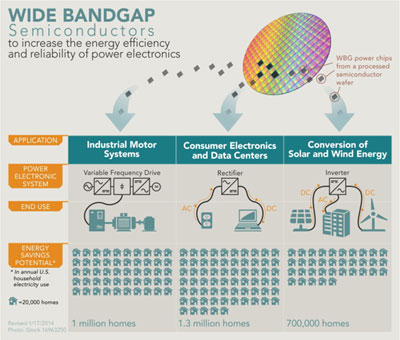Imagine
a power station that’s the size of a suitcase!
That’s what President Obama’s vision is for his first manufacturing innovation
hub, the "Next Generation Power
Electronics Institute."
The North Carolina hub will jumpstart next generation power electronics, so those
ever-smaller devices like tablets and smart phones can become even tinier,
faster, cheaper and more efficient. They are
also integral to electric vehicles, industrial motors and many clean energy
technologies, such as solar and wind inverters that connect them to the grid. The
goal is for these “wide bandgap semiconductors” – 10 times more powerful
that current chips on the market – to
be cost-competitive with silicon semiconductors in five years.
Two other hubs will follow,
all designed to continue his efforts to make the US a the leader on advanced
manufacturing, while creating the well-paying jobs a growing middle class
requires. Together, they will form the President’s National Network of Manufacturing
Innovation.
“In the last century, silicon semiconductors
transformed computing, communication and energy industries, giving individuals
and businesses more and more powerful devices that were once unimaginable,”
says the White House. “For nearly 50 years, silicon chips have been the basis of power
electronics. However, as clean energy technologies and the electronics industry
has advanced, silicon chips are reaching their limits in power conversion —
resulting in wasted heat and higher energy consumption,” explains Ernest Moniz,
Secretary of Energy.
Next generation semiconductors, called wide bandgap semiconductors, can operate
at higher temperatures, voltages and frequencies, giving them the potential to
vastly increase performance while using much less energy. They eliminate up to
90% of the power losses in electricity conversion, for example.
“This in turn means that
power electronics can be smaller because they need fewer semiconductor chips,
and the technologies that rely on power electronics – like electric vehicle
chargers, consumer appliances and LEDs – will perform better, be more
efficient and cost less,” Moniz adds.

With a strong wide bandgap semiconductor manufacturing base, the
US can lead in some of the world’s largest and fastest growing
markets from consumer appliances and industrial-scale equipment to
telecommunications and clean energy technologies, he says.
Led by North Carolina State University, a consortium
of local businesses, universities and federal agencies will co-invest to bridge
the gap between applied research and product development in this arena. North
Carolina is home to world leaders in wide band gap semiconductors on the
manufacturing, materials and research sides.
The Department of Energy is
awarding the hub $70 million over five years, matched by at least that much by
the team of seven universities and 18 companies – including cleantech leaders Cree
and ABB – that have signed on. The state is contributing $10 million.
18 Companies: ABB, APEI, Avogy, Cree, Delphi, Delta Products, DfR
Solutions, Gridbridge, Hesse Mechantronics, II-VI, IQE, John Deere, Monolith
Semiconductor, RF Micro Devices, Toshiba International, Transphorm, USCi, Vacon.
7 Universities and Labs: North Carolina State, University of North Carolina,
Arizona State University, Florida State University, University of California at
Santa Barbara, Virginia Polytechnic Institute, National Renewable Energy
Lab.
First proposed in last year’s
State of the Union address, the three hubs are
being selected using a competitive process. While the Department of Energy leads
the North Carolina hub, the Department of Defense will lead the other two hubs,
to be announced in the coming weeks. One will focus on Digital Manufacturing
and Design Innovation and the other, Lightweight and Modern Metals
Manufacturing. In all, five federal agencies are committing $200 million for
the three hubs: Defense, Energy,
Commerce, NASA, and the National Science Foundation.
All the hubs are conceived as “teaching
factories” – offering education and workforce training, and helping companies –
especially small manufacturers – get access to the
equipment and cutting edge capabilities they need to invent, design, test, and
pilot new semiconductor chips and devices. The institute will also pair
chip designers and manufacturers with large power electronic manufacturers
and suppliers, such as John Deere and Delphi, to bring these technologies to
market faster, says Moniz. The ultimate goal for each hub is to become a global
center of excellence, workforce and education programs.
President Obama’s vision is for a national
network of up to 45 manufacturing innovation institutes, but that require Congress
to pass supportive legislation. This summer, bipartisan bills were introduced
in the House and Senate that would create this network: Senators Brown (D-OH)
and Blunt (R-MO); Reps Reed (R-NY) and Kennedy (D-MA).
The Other Two Hubs:
Digital Manufacturing
and Design Innovation: Advanced design and
manufacturing tools that are digitally integrated and networked with supply
chains can lead to ‘factories of the future’ forming an agile U.S. industrial
base with significant speed to market advantage. A national institute focusing
on the development of novel model-based design methods, virtual manufacturing
tools, and sensor and robotics-based manufacturing networks will accelerate innovation
in digital manufacturing, increasing U.S. competitiveness.
Lightweight and
Modern Metals Manufacturing: Advanced lightweight metals have mechanical and electrical
properties comparable to traditional materials while enabling much lighter
components and products. A national institute will make the U.S. more
competitive by scaling-up research to accelerate market expansion for products
such as wind turbines, medical devices, engines, armored combat vehicles, and
airframes, and lead to significant reductions in manufacturing and energy
costs.
Here is the Next
Generation Power Electronics Institute website:
